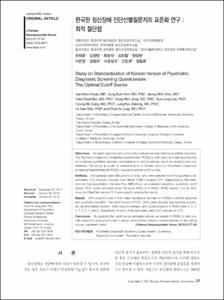한국판 정신장애 진단선별질문지의 표준화 연구 : 최적 절단점
- Keimyung Author(s)
- Kim, Jung Bum; Jung, Sung Won; Jung, Chul Ho
- Department
- Dept. of Psychiatry (정신건강의학)
- Journal Title
- 신경정신의학
- Issued Date
- 2012
- Volume
- 51
- Issue
- 2
- Keyword
- Psychiatric Diagnostic Screening Questionnaire; Screening; Diagnostic instrument; Psychiatric disorder
- Abstract
- OBJECTIVES: An exact diagnosis and comorbidity analysis are important in psychiatric disorders. The Psychiatric Diagnostic Screening Questionnaire (PDSQ) is both useful as a self-reporting test for screening psychiatric disorders and available for clinical settings due to its simplicity and convenience. This study, as a part of standardization of Korean version of Psychiatric Diagnostic Screening Questionnaire (K-PDSQ), evaluated optimal cutoff scores. METHODS: The samples were 696 patients in total, who were selected from the psychiatric departments of 3 university hospitals from March 2008 to August 2011. Diagnosing by Mini-International Neuropsychiatric Interview-Plus (MINI-Plus), we evaluated sensitivity, specificity, cutoff scores, ROC curve, and area under the curve (AUC) of K-PDSQ. SPSS version 12.0 for Windows and MedCalc version 12.0 were used to analyze the results. RESULTS: With a cutoff score of 9 for major depressive disorder in K-PDSQ, both the sensitivity and specificity were 80%. The cutoff scores of PTSD, OCD, panic disorder, agoraphobia, psychosis, alcohol related problem, GAD, hypochondriasis, and social phobia of K-PDSQ were 5, 2, 4, 2, 1, 2, 5, 4, and 5, respectively. In most of the subscales, each AUC was above 0.75. CONCLUSION: By applying the cutoff scores estimated above, we expect K-PDSQ to help provide diagnostic assessments and to grasp comorbidities before a clinical interview in the setting of busy outpatient clinics.
- Alternative Title
- Study on Standardization of Korean Version of Psychiatric Diagnostic Screening Questionnaire : The Optimal Cutoff Scores
- Publisher
- School of Medicine
- Citation
- 곽재훈 et al. (2012). 한국판 정신장애 진단선별질문지의 표준화 연구 : 최적 절단점. 신경정신의학, 51(2), 77–84.
- Type
- Article
- ISSN
- 1015-4817
- Appears in Collections:
- 1. School of Medicine (의과대학) > Dept. of Psychiatry (정신건강의학)
- 파일 목록
-
-
Download
 oak-bbb-4749.pdf
기타 데이터 / 730.88 kB / Adobe PDF
oak-bbb-4749.pdf
기타 데이터 / 730.88 kB / Adobe PDF
-
Items in Repository are protected by copyright, with all rights reserved, unless otherwise indicated.